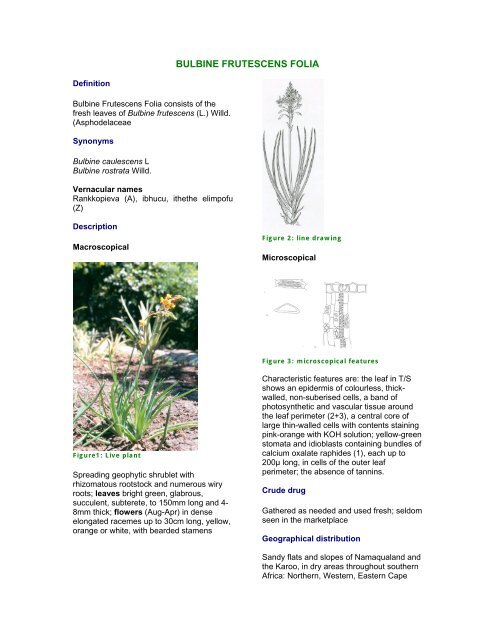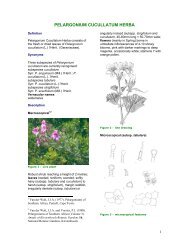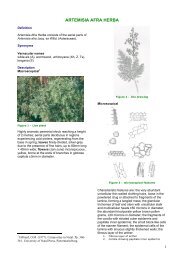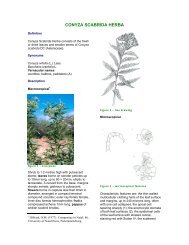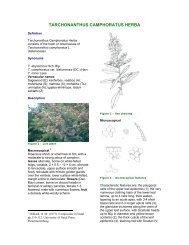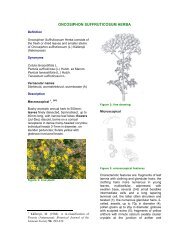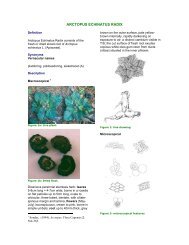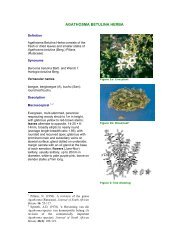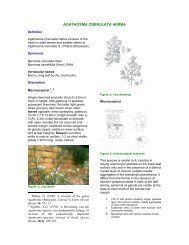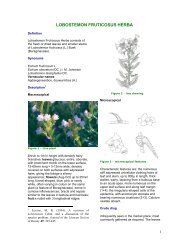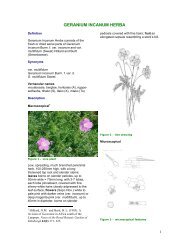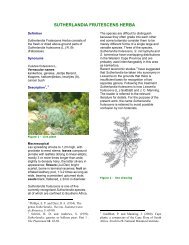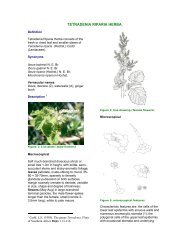BULBINE FRUTESCENS FOLIA - PlantZAfrica
BULBINE FRUTESCENS FOLIA - PlantZAfrica
BULBINE FRUTESCENS FOLIA - PlantZAfrica
Create successful ePaper yourself
Turn your PDF publications into a flip-book with our unique Google optimized e-Paper software.
Definition<br />
Bulbine Frutescens Folia consists of the<br />
fresh leaves of Bulbine frutescens (L.) Willd.<br />
(Asphodelaceae<br />
Synonyms<br />
Bulbine caulescens L<br />
Bulbine rostrata Willd.<br />
Vernacular names<br />
Rankkopieva (A), ibhucu, ithethe elimpofu<br />
(Z)<br />
Description<br />
Macroscopical<br />
Figure1: Live plant<br />
Spreading geophytic shrublet with<br />
rhizomatous rootstock and numerous wiry<br />
roots; leaves bright green, glabrous,<br />
succulent, subterete, to 150mm long and 4-<br />
8mm thick; flowers (Aug-Apr) in dense<br />
elongated racemes up to 30cm long, yellow,<br />
orange or white, with bearded stamens<br />
<strong>BULBINE</strong> <strong>FRUTESCENS</strong> <strong>FOLIA</strong><br />
Figure 2: line drawing<br />
Microscopical<br />
Figure 3: microscopical features<br />
Characteristic features are: the leaf in T/S<br />
shows an epidermis of colourless, thickwalled,<br />
non-suberised cells, a band of<br />
photosynthetic and vascular tissue around<br />
the leaf perimeter (2+3), a central core of<br />
large thin-walled cells with contents staining<br />
pink-orange with KOH solution; yellow-green<br />
stomata and idioblasts containing bundles of<br />
calcium oxalate raphides (1), each up to<br />
200µ long, in cells of the outer leaf<br />
perimeter; the absence of tannins.<br />
Crude drug<br />
Gathered as needed and used fresh; seldom<br />
seen in the marketplace<br />
Geographical distribution<br />
Sandy flats and slopes of Namaqualand and<br />
the Karoo, in dry areas throughout southern<br />
Africa: Northern, Western, Eastern Cape
and Free State Provinces, Lesotho,<br />
KwaZulu-Natal.<br />
Figure 4: distribution map<br />
Quality standards<br />
Identity tests<br />
Thin layer chromatography on silica gel<br />
using as solvent a mixture of toluene:diethyl<br />
ether:1.75M acetic acid (1:1:1). Reference<br />
compound cineole (0,1% in chloroform).<br />
Method according to Appendix 2a. (figure 5)<br />
Rf values of major compounds: 0.5 (orange);<br />
0.55 (light purple); 0.67 (purple); 0.8 (pale<br />
green); 0.83 (light purple); cineole: 0.76<br />
(blue-purple).<br />
Figure 5: TLC plate<br />
HPLC on C18 column, method according to<br />
Appendix 2b.<br />
Major compounds:<br />
Methanol extract: (figure 6)<br />
Figure 6: HPLC spectrum<br />
Retention times (mins): 3.05 ; 5.95 ; 17.49;<br />
17.84<br />
Total ash: 9.32% (determined according to<br />
the BHP 1996 using 1.0g dried ground<br />
material; a pale grey-yellow residue remains<br />
after ignition in muffle furnace).<br />
Loss on drying: loses not less than 94%<br />
(range: 94.3-95.66%) of its weight on drying<br />
in an oven at 105ºC for three days.<br />
Purity tests<br />
Assay<br />
Not yet available<br />
Major chemical constituents 1<br />
The biaryl anthraquinones knipholone and<br />
isoknipholone, based on a chrysophanol<br />
skeleton (see figure 7), have been isolated<br />
from the roots of Bulbine frutescens as well<br />
as from other Bulbine species 2 . These differ<br />
from the anthraquinones of the related<br />
genus Aloe (subfamily Alooideae) in that the<br />
latter are mainly aloe-emodin derivatives.<br />
Knipholone, together with two new<br />
phenylanthraquinones (Gaboroquinones A<br />
and B) and a demethylknipholone glucoside,<br />
1 Van Staden, L.F. and Drewes, S.E. (1994).<br />
Knipholone from Bulbine latifolia and Bulbine<br />
frutescens. Phytochemistry 35(3): 685-686.<br />
2 Van Wyk, B-E., Yenesew, A. and Dagne, E.<br />
(1995). Chemotaxonomic significance of<br />
anthraquinones in the roots of Asphodeloideae<br />
(Asphodelaceae). Biochemical Systematics and<br />
Ecology 23(3): 277-281.
have been isolated from the roots of plants<br />
growing in Botswana 3 .<br />
Figure 7: chemical constituents<br />
Dosage forms<br />
Fresh leaf juice is usually applied directly to<br />
the skin.<br />
Medicinal uses<br />
GR1, 12, 20<br />
Some 41 Bulbine species occur in South<br />
Africa and 6-7 are used medicinally; the leaf<br />
gel of most of these is used, the species<br />
possibly interchangeably, as an external<br />
application for the treatment of sores,<br />
wounds, skin rashes, cracked lips, eczema<br />
and ringworm; less often also to relieve<br />
sciatica. Whereas the underground parts of<br />
the other 6-7 species are used to prepare<br />
enemata or infusions for oral administration<br />
to treat diarrhoea, colic, urinary tract<br />
infections and venereal diseases, only the<br />
leaf juice of B.frutescens appears to have<br />
found a place in traditional medical practice.<br />
Pharmacology/bioactivity<br />
Aqueous and methanolic extracts of dried<br />
leaf, investigated for in vitro antimicrobial<br />
activity against Staphylococcus aureus, S.<br />
epidermidis and Bacillis subtilis, were found<br />
to be inactive (conc.1mg/ml) 4<br />
Knipholone has been tested for in vitro<br />
antimicrobial activity against Escherichia<br />
3 Abegaz, B. et al. (2002). Gaboroquinones A<br />
and B and 4’-O-demethylknipholone-4’-O-ß-Dglucopyranoside,<br />
phenylanthraquinones from the<br />
roots of Bulbine frutescens. Journal of Natural<br />
Products 65(8): 1117-1121.<br />
4 Rabe, T. and van Staden, J. (1997).<br />
Antibacterial activity of South African plants<br />
used for medicinal purposes. Journal of<br />
Ethnopharmacology 56: 81-87.<br />
coli, Pseudomonas aeruginosa,<br />
Staphylococcus aureus, Bacillus subtilis,<br />
Micrococcus luteus and Candida albicans 1 ,<br />
but was found to be inactive. No other<br />
information is available regarding the<br />
bioactivity of B. frutescens.<br />
Contraindications<br />
None known<br />
Adverse reactions<br />
Brown staining of the skin after using the<br />
leaf gel is reported GR1<br />
Precautions<br />
No special precautions<br />
Dosage<br />
To be applied frequently to the affected<br />
parts for 7 days. If symptoms persist,<br />
alternative therapy should be sought.<br />
Copyright in this monograph resides with the authors, the South<br />
African National Biodiversity Institute, the South African Medical<br />
Research Council and the University of the Western Cape. It may<br />
not be reproduced in whole or in part without the written consent of<br />
the copyright holders.


